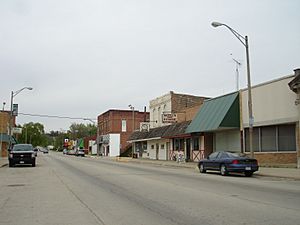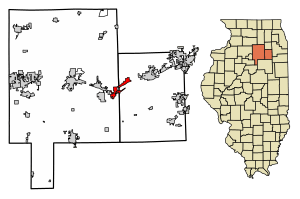Seneca, Illinois facts for kids
Quick facts for kids
Seneca, Illinois
|
|
|---|---|

Business district in Seneca
|
|

Location of Seneca in Grundy County, Illinois.
|
|

Location of Illinois in the United States
|
|
| Country | United States |
| State | Illinois |
| Counties | LaSalle, Grundy |
| Townships | Manlius, Brookfield, Erienna, Norman |
| Area | |
| • Total | 6.58 sq mi (17.03 km2) |
| • Land | 6.21 sq mi (16.08 km2) |
| • Water | 0.37 sq mi (0.95 km2) |
| Elevation | 614 ft (187 m) |
| Population
(2020)
|
|
| • Total | 2,353 |
| • Density | 378.97/sq mi (146.31/km2) |
| Time zone | UTC-6 (CST) |
| • Summer (DST) | UTC-5 (CDT) |
| ZIP Code(s) |
61360
|
| Area code(s) | 815 |
| FIPS code | 17-68640 |
| GNIS feature ID | 2399784 |
| Wikimedia Commons | Seneca, Illinois |
Seneca is a small village in Illinois, a state in the United States. It is located in both LaSalle and Grundy counties. In 2020, about 2,353 people lived there.
Most of Seneca is in the Ottawa area. A smaller part of the village is in Grundy County. This part is considered part of the larger Chicago metropolitan area.
Contents
History of Seneca
Early Beginnings and a Missionary's Story
Long ago, in 1680, a French missionary named Father Gabriel de la Ribourde visited the Seneca area. He was exploring with a group from Quebec. Sadly, he was attacked and died there. A wooden cross near St. Patrick's Catholic Church marks the spot where he is believed to have passed away. He is remembered as the first Catholic martyr in Illinois.
How Seneca Got Its Name
Seneca was first settled by a man named Jeremiah Crotty. He was a businessman and helped build the Illinois and Michigan Canal. In 1850, Crotty built the first house in the area. He also set up a post office in 1854. For a long time, people called the town "Crotty Town."
It wasn't until 1957 that the town officially became "Seneca." Even before then, many local people already called it Seneca. The village was officially recognized in 1865. It grew because of the canal, the Rock Island Railroad, and the Illinois River.
Seneca's Role in World War II
Seneca is famous for its important work during World War II. A company called Chicago Bridge and Iron ran the Prairie Shipyard here. This shipyard built 157 Landing Ship, Tanks (LSTs). These were special ships used to carry tanks and troops during the war.
Where is Seneca?
Seneca is located at coordinates 41°18′40″N 88°36′35″W / 41.31111°N 88.60972°W. It covers about 6.58 square miles (17.03 square kilometers). Most of this area is land, with a small part being water.
The village is mainly in LaSalle County. Only a small piece of it reaches into Grundy County. Seneca sits right on the Illinois River. This river is very important because it connects Lake Michigan to the mighty Mississippi River.
People of Seneca
| Historical population | |||
|---|---|---|---|
| Census | Pop. | %± | |
| 1880 | 738 | — | |
| 1890 | 1,190 | 61.2% | |
| 1900 | 1,036 | −12.9% | |
| 1910 | 1,005 | −3.0% | |
| 1920 | 994 | −1.1% | |
| 1930 | 1,185 | 19.2% | |
| 1940 | 1,235 | 4.2% | |
| 1950 | 1,435 | 16.2% | |
| 1960 | 1,719 | 19.8% | |
| 1970 | 1,781 | 3.6% | |
| 1980 | 2,098 | 17.8% | |
| 1990 | 1,878 | −10.5% | |
| 2000 | 2,053 | 9.3% | |
| 2010 | 2,371 | 15.5% | |
| 2020 | 2,353 | −0.8% | |
| U.S. Decennial Census | |||
In 2020, 2,353 people lived in Seneca. The population density was about 357.82 people per square mile. The average age of people in the village was around 34.8 years old. About 26.3% of the population was under 18 years old.
Businesses in Seneca
Seneca's location on the Illinois River is great for business. The river links Lake Michigan to the Mississippi River. Seneca has three marinas on the south side of the river. There is also a public boat launch on the north side.
The historic Illinois and Michigan Canal runs right through downtown Seneca. This adds to the village's unique charm. Local businesses and shops are working together to make the business community even better. They also want to attract new businesses to the area.
The village has a group called The Seneca Business Association. This group helps local businesses work together. They promote shopping locally and help improve the downtown area. They have created a business directory and organized fundraisers for local charities.
Schools in Seneca
Seneca has three schools, which are part of two different school districts:
- Seneca Grade School North Campus: For students from pre-kindergarten to 4th grade.
- Seneca Grade School South Campus: For students in grades 5-8.
- Seneca Township High School: For students in grades 9-12. This school also welcomes students from nearby towns like Mazon, Verona, Kinsman, and Marseilles.
In the past, Seneca High School received a lot of funding. This was partly due to payments from a power plant located nearby. This extra funding helped the schools provide more resources for students. However, these payments have since decreased.
Sports Achievements
Seneca schools have a strong history in sports:
- In 1986, the Seneca Lady Irish basketball team won the Class 1A State Championship. They had a perfect 30-0 record!
- In 1989, the Seneca Fighting Irish Cross Country team won the Class 1A State Championship. They were the first boys' team from LaSalle County to win a state championship.
- In 1990, the Seneca Fighting Irish Track team's 3200-meter relay team won the Class 1A State Championship.
- Also in 1990, the Seneca Fighting Irish football team won the Class 2A State Championship with a 14-0 record.
- In 2006, the Seneca Fighting Irish basketball team won the Class 1A State Championship with a 35-0 record.
- The Seneca High School FFA (Future Farmers of America) has been named the top chapter in Illinois.
- In 2018, Christopher Collet won the IHSA State Cross Country Championships.
- In 2019, Christopher Collet won both the 1600m and 3200m runs at the IHSA State Track meet.
Famous People from Seneca
- Dave Callahan: An outfielder who played baseball for the Cleveland Naps. He was born in Seneca.
- John Tracy Ellis: A well-known historian who studied the Catholic church. He was also born in Seneca.
See also
 In Spanish: Seneca (Illinois) para niños
In Spanish: Seneca (Illinois) para niños

